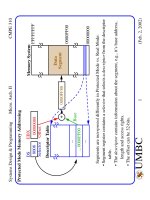Thiết kế và lập trình hệ thống - Chương 31
Bạn đang xem bản rút gọn của tài liệu. Xem và tải ngay bản đầy đủ của tài liệu tại đây (286.53 KB, 12 trang )
Systems Programming Linux Device Drivers V CMPE 310
1 (May 11, 2000 2:08 pm)
UMBC
U M B C
U
N
I
V
E
R
S
I
T
Y
O
F
M
A
R
Y
L
A
N
D
B
A
L
T
I
M
O
R
E
C
O
U
N
T
Y
1
9
6
6
Hardware Management
We will develop code that is designed to control the parallel port.
First we will look at the kernel functions that allow communication to 8-bit,
16-bit and 32-bit I/O ports.
unsigned inb(unsigned port);
void outb(unsigned char byte, unsigned port);
Read and write 8-bit wide ports.
The port argument is defined as unsigned long on some and
unsigned short on other platforms.
unsigned inw(unsigned port);
void outw(unsigned short word, unsigned port);
The 16-bit versions.
unsigned inl(unsigned port);
void outl(unsigned doubleword, unsigned port);
The 32-bit versions in which doubleword is defined as unsigned long
or unsigned int, according to the platform.
Systems Programming Linux Device Drivers V CMPE 310
2 (May 11, 2000 2:08 pm)
UMBC
U M B C
U
N
I
V
E
R
S
I
T
Y
O
F
M
A
R
Y
L
A
N
D
B
A
L
T
I
M
O
R
E
C
O
U
N
T
Y
1
9
6
6
Parallel Port
On the 80x86, it is possible that the processor tries to transfer data too quickly
to and from the bus, particularly if the I/O instructions are back-to-back.
There are inb_p and outb_p (pause) versions of the above functions.
You can use SLOW_DOWN_IO macro to add the delay also.
There are also string functions defi ned as follows:
void insb(unsigned port, void *addr, unsigned long
cnt);
void outsb(unsigned port, void *addr, unsigned long
cnt);
Along with the w and l versions for 16-bit and 32-bit transfers.
Parallel Port
The parallel port, in its minimal confi guration, is made up of a few 8-bit
ports.
Data written to the output port shows up on the output pins of the 25-pin
connector at standard TTL levels (0 and 5 volts w/ threshold of 1.2 V).
Systems Programming Linux Device Drivers V CMPE 310
3 (May 11, 2000 2:08 pm)
UMBC
U M B C
U
N
I
V
E
R
S
I
T
Y
O
F
M
A
R
Y
L
A
N
D
B
A
L
T
I
M
O
R
E
C
O
U
N
T
Y
1
9
6
6
Parallel Port
The parallel port specifi cation.
13
12
11
10
9
8
7
6
25
24
23
22
21
20
19
18
5
4
3
2
1
17
16
15
14
Control Port: base_addr+2
01234567
irq enable
01234567
Status Port: base_addr+1
01234567
Data Port: base_addr+0
23456789
8
10
12
13 15
Output Control
Input Status
11
17 16
14
1
Input Data
Inverted
DB25
Systems Programming Linux Device Drivers V CMPE 310
4 (May 11, 2000 2:08 pm)
UMBC
U M B C
U
N
I
V
E
R
S
I
T
Y
O
F
M
A
R
Y
L
A
N
D
B
A
L
T
I
M
O
R
E
C
O
U
N
T
Y
1
9
6
6
Interrupt Handling
Control Port bit 4 is not connected to the DB25 connector, but rather it is used
to enable interrupts.
outb is used at module initialization time to do this.
The device generates an interrupt by raising pin 10 (the “ACK” bit).
Of course, nothing will happen until an interrupt service routine has been
installed.
Linux acknowledges and ignores any unexpected interrupts.
There are only 15 or 16 interrupt lines and the kernel keeps a registry of inter-
rupt lines (similar to the I/O port registry).
Systems Programming Linux Device Drivers V CMPE 310
5 (May 11, 2000 2:08 pm)
UMBC
U M B C
U
N
I
V
E
R
S
I
T
Y
O
F
M
A
R
Y
L
A
N
D
B
A
L
T
I
M
O
R
E
C
O
U
N
T
Y
1
9
6
6
Obtaining Interrupt Request Numbers
A module requests and frees an interrupt channel (IRQ) using functions
declared in <linux/sched.h>:
extern int request_irq(unsigned int irq,
void (*handler)(int, void *, struct pt_regs *),
unsigned long flags,
const char *device,
void *dev_id);
extern void free_irq(unsigned int irq, void *dev_id);
• irq is the requested IRQ (which may not correspond to the hardware num-
ber).
• handler is a pointer to the ISR.
• flags is a bitmask of options related to interrupt management.
• device is the string used in /proc/interrupts to show the owner of the inter-
rupt.
• dev_id is a unique identifi er used for shared interrupt lines and is usually
set to NULL.









